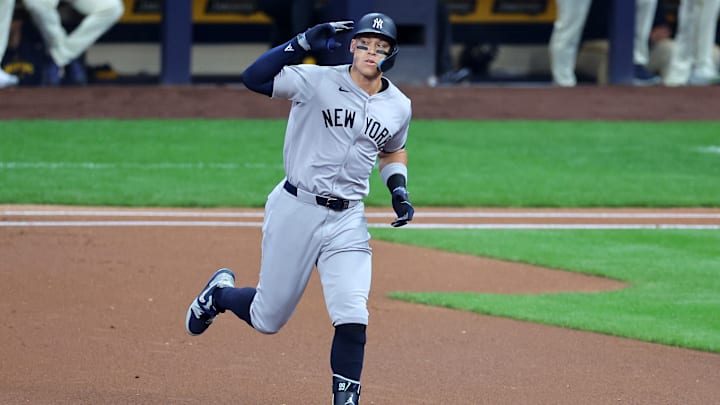In an otherwise uneventful New York Yankees 15-5 win over the Milwaukee Brewers, few things stood out outside of the sixth inning. And, no, I'm not talking about the seven runs they scored to blow the game open. Or, well, I'm talking about the play that kickstarted all of that, so kind of, I guess.
With one out and Judge at first base, Alex Verdugo hit into what looked like an inning-ending double play, but the throw from second to first was broken up by the outstretched arm of the 6-foot-7 Judge. Regardless of that, as Pat Murphy alleged, runner's interference should've been called, thus ruling Verdugo out at first and ending the inning. Instead, the inning continued and the Yankees got their two-out rally that got them a series win over the Brewers, helping them score 15 runs for the second straight game.
Judge defended himself postgame, pointing out that he's always done his slides to second the same way. And, believe it or not, he's actually right
A compilation of Aaron Judge sliding exactly how he did today
— Talkin' Yanks (@TalkinYanks) April 28, 2024
(via @SinatraRL) pic.twitter.com/Jz0tif11WF
So, with that in mind, one would think that, since he does it all the time, it's a natural part of his slide. However, the crew chief for yesterday's game, Andy Fletcher, admitted after the fact that the crew got the call wrong on the field:
""On the field, we got together and did the best that we could to come up with the correct answer. After looking at it off the field in replay, it appears that the call was missed," Fletcher told a pool reporter. "It should’ve been called interference because it wasn’t a natural part of his slide. It didn’t appear that way to us. We did everything we could to get together and get it right. But after looking at it, it appears that it should’ve been called interference""Andy Fletcher
Yankees got away with one thanks to Aaron Judge
While Fletcher didn't specify which part of the slide wasn't natural, one can assume he's talking about the hand, which is what broke up the throw from shortstop Willy Adames.
Aaron Judge with the… block? pic.twitter.com/ZkzEL5TsXg
— Talkin’ Baseball (@TalkinBaseball_) April 28, 2024
And, while it's fact that Judge has done it before, just because he hasn't broken up a play with it it doesn't make it legal. At least according to the rulebook.
Rule 6.01 of the MLB Rulebook (amended in 2021), titled "Interference, Obstruction, and Catcher Collisions" states the following about a play like this:
"If, in the judgment of the umpire, a base runner willfully and deliberately interferes with a batted ball or a fielder in the act of fielding a batted ball with the obvious intent to break up a double play, the ball is dead. The umpire shall call the runner out for interference and also call out the batter-runner because of the action of his teammate. In no event may bases be run or runs scored because of such action by a runner (see Rule 6.01(j));".
So, if the rule was applied, the Yankees should've had no runners on base, and the subsequent Giancarlo Stanton popout should've ended the inning. Instead, the Yankees feasted on Milwaukee.
While Judge is right about the history of his slides, it doesn't make the play legal.
